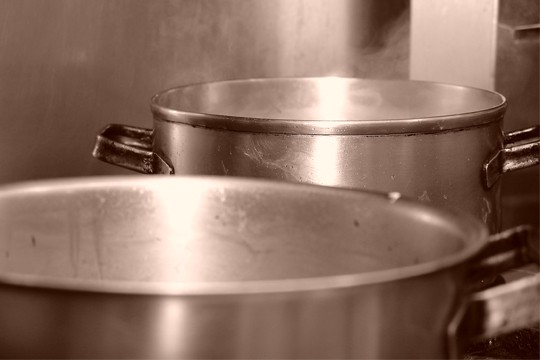
Reducing Food Waste in Foodservice
October 16, 2018 by Doreen Garelick, Dietetic Intern
Our intern Doreen attended a food waste summit for restaurants and compiled these tips to help food service operators redirect…
Nutrition 101
December 31, 2012

Culinary Nutritionist Natalia Hancock takes us through the simple steps involved in making your own delicious and nutritious chicken stock.
Preparing your own stock is a very nutritious and sustainable way of cooking. Chicken stock can provide nutrients such as calcium, phosphorus, magnesium, sulfur, fluoride, potassium, chondrotin, keratin, lysine, and many other minerals that are not so abundant in our diet. Additionally, cooking with stock is a very healthy way to add flavor without adding many calories. Purchasing stocks can be expensive and many are unnecessarily high in sodium.
A great time to prepare a stock is when you have you have roasted a chicken. Whenever I roast chicken (once a week), I utilize every possible part, saving the bones and the drippings (see this post on roasting your own chicken).
A recipe for stock need not contain exact amounts, but here are some sustainable tips to follow:
Place chicken bones and vegetable scraps in a large pot and cover with cold water. Add any chicken juices if you have them. Heat to a boil and reduce to a simmer. Add a squeeze of lemon or tablespoon of vinegar. Peppercorns and a bay leaf or two can be added for additional flavor. Simmer an hour or two uncovered. If your stock cooks down several inches, add more water. Once the stock has cooled, skim impurities from the top and strain into freezer-safe containers and label.
To make a vegetable stock, withhold the chicken and add extra vegetables. Shrimp and lobster shells make great stock as well. If the shrimp shells are raw, roast them in the oven on 350 for 10 minutes until they are pink then add them to the vegetable scraps in place of chicken. You can do the same with cooked meat bones as well.
So, now that you have your freezer packed with stock, here are some ideas of how to cook with it:
A proper stock is crucial when preparing my recipe for healing chicken soup.

October 16, 2018 by Doreen Garelick, Dietetic Intern
Our intern Doreen attended a food waste summit for restaurants and compiled these tips to help food service operators redirect food waste from landfills.
Nutrition 101

Nutrition 101
September 26, 2018 by Doreen Garelick, Dietetic Intern
Ever notice headlines about rapid weightloss? Dietetic Intern Doreen Garelick looks deeper into a recent eye-catching headline to see if there's any truth behind it.
Connect
 Follow us on Twitter
Follow us on Twitter Friend us on Facebook
Friend us on Facebook Follow us on Pinterest
Follow us on Pinterest Follow us on Instagram
Follow us on Instagram Read our Blog
Read our Blog Watch videos on YouTube
Watch videos on YouTube Watch videos on Vimeo
Watch videos on Vimeo Connect with us on Linkedin
Connect with us on Linkedin Find us on Foursquare
Find us on Foursquare
Tweets by @SPEcertifiedBlog Search
Categories
SPE Certified Newsletter
Sign up for news on the latest SPE-certified venues, events and SPE updates.
We will never share your personal information with a third party.